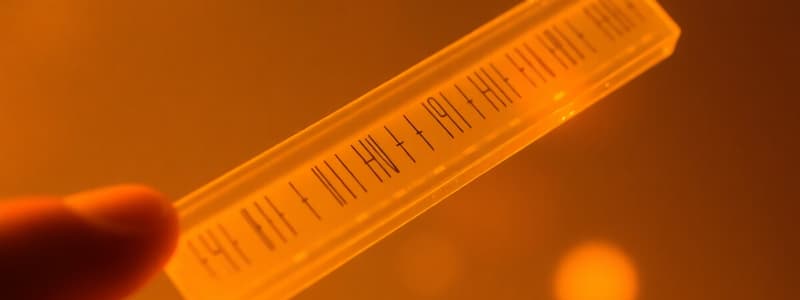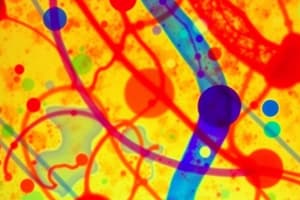Podcast
Questions and Answers
Which of the following is NOT a reason why electrophoretic media are used in electrophoresis?
Which of the following is NOT a reason why electrophoretic media are used in electrophoresis?
- Chemical fractionation of molecules (correct)
- Stability
- Resolution
- Repetition
What is the primary purpose of an electrophoretic medium in electrophoresis?
What is the primary purpose of an electrophoretic medium in electrophoresis?
- To provide a stable environment for the electrophoresis process (correct)
- To act as a source of electric current
- To facilitate the binding of DNA to the electrodes
- To chemically modify the DNA molecules
Which of the following is NOT a characteristic of an ideal electrophoretic medium?
Which of the following is NOT a characteristic of an ideal electrophoretic medium?
- It should be able to chemically modify the molecules being separated (correct)
- It should be able to be easily modified to change pore size
- It should be inert to the molecules being separated
- It should be able to stabilize the electrolyte solution
In electrophoresis, why does a negatively charged molecule migrate towards the anode?
In electrophoresis, why does a negatively charged molecule migrate towards the anode?
What is the primary factor that determines the speed of migration of a DNA molecule in an electrophoretic medium?
What is the primary factor that determines the speed of migration of a DNA molecule in an electrophoretic medium?
Which of the following is a commonly used gel for DNA electrophoresis?
Which of the following is a commonly used gel for DNA electrophoresis?
What is the source of agarose used in electrophoresis?
What is the source of agarose used in electrophoresis?
What factor primarily stabilizes the network of polymers within an agarose gel?
What factor primarily stabilizes the network of polymers within an agarose gel?
Which of the following statements is TRUE regarding the use of agarose gels for DNA separation?
Which of the following statements is TRUE regarding the use of agarose gels for DNA separation?
Why is a comb used during the preparation of an agarose gel?
Why is a comb used during the preparation of an agarose gel?
Which of the following buffers is commonly used in agarose gel electrophoresis?
Which of the following buffers is commonly used in agarose gel electrophoresis?
Why is it necessary to cool the agarose solution to approximately 60 degrees Celsius before pouring it into the mold?
Why is it necessary to cool the agarose solution to approximately 60 degrees Celsius before pouring it into the mold?
How long does it typically take for an agarose gel to solidify after pouring?
How long does it typically take for an agarose gel to solidify after pouring?
What is the primary purpose of the electrophoretic buffer used in agarose gel electrophoresis?
What is the primary purpose of the electrophoretic buffer used in agarose gel electrophoresis?
During gel electrophoresis, what determines the direction of DNA migration?
During gel electrophoresis, what determines the direction of DNA migration?
Why is it important to prevent the formation of air bubbles in the agarose gel?
Why is it important to prevent the formation of air bubbles in the agarose gel?
Why is it essential to use the same buffer that the gel was cast in for the electrophoresis chamber?
Why is it essential to use the same buffer that the gel was cast in for the electrophoresis chamber?
Which of the following statements is NOT true regarding the effect of agarose concentration on DNA separation in electrophoresis?
Which of the following statements is NOT true regarding the effect of agarose concentration on DNA separation in electrophoresis?
What is the primary reason for the smudging of DNA fragments larger than 12-15 kbp when using high voltage in electrophoresis?
What is the primary reason for the smudging of DNA fragments larger than 12-15 kbp when using high voltage in electrophoresis?
What is the most likely consequence of using a low voltage during DNA electrophoresis?
What is the most likely consequence of using a low voltage during DNA electrophoresis?
Which of the following correctly describes the relationship between the voltage applied and the migration speed of DNA molecules in electrophoresis?
Which of the following correctly describes the relationship between the voltage applied and the migration speed of DNA molecules in electrophoresis?
What is the main purpose of using buffers in DNA electrophoresis?
What is the main purpose of using buffers in DNA electrophoresis?
Why are Tris/Acetate/EDTA (TAE) and Tris/Borate/EDTA (TBE) commonly used buffers for DNA electrophoresis?
Why are Tris/Acetate/EDTA (TAE) and Tris/Borate/EDTA (TBE) commonly used buffers for DNA electrophoresis?
What is the significance of the 'smiling' effect observed in DNA bands during electrophoresis?
What is the significance of the 'smiling' effect observed in DNA bands during electrophoresis?
If no salts were present in the electrophoresis buffer, what would be the most likely outcome?
If no salts were present in the electrophoresis buffer, what would be the most likely outcome?
Which of the following factors would NOT influence the electrophoretic mobility of DNA in agarose gels?
Which of the following factors would NOT influence the electrophoretic mobility of DNA in agarose gels?
What is the main advantage of using TBE buffer over TAE buffer for DNA electrophoresis?
What is the main advantage of using TBE buffer over TAE buffer for DNA electrophoresis?
Given the relationship between agarose concentration and pore size, which of the following statements is true?
Given the relationship between agarose concentration and pore size, which of the following statements is true?
What is the primary characteristic that determines the migration speed of DNA molecules during electrophoresis in an agarose gel?
What is the primary characteristic that determines the migration speed of DNA molecules during electrophoresis in an agarose gel?
Which of these factors does NOT directly influence the relative mobility of DNA during agarose gel electrophoresis?
Which of these factors does NOT directly influence the relative mobility of DNA during agarose gel electrophoresis?
Why is agarose gel electrophoresis generally not optimal for separating very small DNA fragments (less than 100 bp)?
Why is agarose gel electrophoresis generally not optimal for separating very small DNA fragments (less than 100 bp)?
What is the relationship between the migration speed of linear dsDNA molecules and the number of base pairs?
What is the relationship between the migration speed of linear dsDNA molecules and the number of base pairs?
Which of the following is NOT an advantage of agarose gel electrophoresis for separating DNA?
Which of the following is NOT an advantage of agarose gel electrophoresis for separating DNA?
What is the primary reason why DNA molecules migrate towards the positive electrode (anode) during electrophoresis?
What is the primary reason why DNA molecules migrate towards the positive electrode (anode) during electrophoresis?
How does the size of the DNA molecule affect its migration speed through an agarose gel?
How does the size of the DNA molecule affect its migration speed through an agarose gel?
What is the purpose of using a buffer solution during agarose gel electrophoresis?
What is the purpose of using a buffer solution during agarose gel electrophoresis?
Which of the following statements accurately describes the purpose of adding Midori Green dye to the dissolved agarose?
Which of the following statements accurately describes the purpose of adding Midori Green dye to the dissolved agarose?
Which of the following statements accurately describes the purpose of the DNA ladder in electrophoresis?
Which of the following statements accurately describes the purpose of the DNA ladder in electrophoresis?
What is the primary reason for the need to stabilize the pipette tip with a finger when loading DNA samples onto the gel?
What is the primary reason for the need to stabilize the pipette tip with a finger when loading DNA samples onto the gel?
Why is it important to only partially insert the pipette tip into the well when loading DNA samples?
Why is it important to only partially insert the pipette tip into the well when loading DNA samples?
What is the reason for using a buffer in the electrophoresis apparatus?
What is the reason for using a buffer in the electrophoresis apparatus?
Flashcards
Electrophoresis
Electrophoresis
A technique where charged molecules move in an electric field through a medium.
Anaphoresis
Anaphoresis
Movement of negatively charged molecules towards the positive electrode (anode).
Cathaphoresis
Cathaphoresis
Movement of positively charged molecules towards the negative electrode (cathode).
Electrophoretic Medium
Electrophoretic Medium
Signup and view all the flashcards
Gel Electrophoresis
Gel Electrophoresis
Signup and view all the flashcards
Agarose
Agarose
Signup and view all the flashcards
Molecular Sieve Principle
Molecular Sieve Principle
Signup and view all the flashcards
TAE/TBE buffer
TAE/TBE buffer
Signup and view all the flashcards
Comb
Comb
Signup and view all the flashcards
Cooling of agarose
Cooling of agarose
Signup and view all the flashcards
Molecular size separation
Molecular size separation
Signup and view all the flashcards
Agarose concentration
Agarose concentration
Signup and view all the flashcards
200 bp and 300 bp
200 bp and 300 bp
Signup and view all the flashcards
5000 bp and 6000 bp
5000 bp and 6000 bp
Signup and view all the flashcards
Hydrogen bonds in agarose
Hydrogen bonds in agarose
Signup and view all the flashcards
Midori Green dye
Midori Green dye
Signup and view all the flashcards
DNA ladder
DNA ladder
Signup and view all the flashcards
PCR Mix Plus Green
PCR Mix Plus Green
Signup and view all the flashcards
Loading buffer
Loading buffer
Signup and view all the flashcards
Pore size regulation
Pore size regulation
Signup and view all the flashcards
Advantages of agarose electrophoresis
Advantages of agarose electrophoresis
Signup and view all the flashcards
DNA migration in electrophoresis
DNA migration in electrophoresis
Signup and view all the flashcards
DNA fragment size range
DNA fragment size range
Signup and view all the flashcards
Impact of agarose on DNA mobility
Impact of agarose on DNA mobility
Signup and view all the flashcards
Factors affecting DNA mobility
Factors affecting DNA mobility
Signup and view all the flashcards
Reversibility of agarose gel
Reversibility of agarose gel
Signup and view all the flashcards
Disadvantages of agarose electrophoresis
Disadvantages of agarose electrophoresis
Signup and view all the flashcards
Agarose concentration (0.3% w/v)
Agarose concentration (0.3% w/v)
Signup and view all the flashcards
Agarose concentration (0.6% w/v)
Agarose concentration (0.6% w/v)
Signup and view all the flashcards
Agarose concentration (1.2% w/v)
Agarose concentration (1.2% w/v)
Signup and view all the flashcards
Voltage in electrophoresis
Voltage in electrophoresis
Signup and view all the flashcards
Recommended voltage range
Recommended voltage range
Signup and view all the flashcards
Electrophoretic mobility
Electrophoretic mobility
Signup and view all the flashcards
Importance of buffer in electrophoresis
Importance of buffer in electrophoresis
Signup and view all the flashcards
Common buffers for DNA
Common buffers for DNA
Signup and view all the flashcards
TAE vs. TBE
TAE vs. TBE
Signup and view all the flashcards
Effect of low voltage
Effect of low voltage
Signup and view all the flashcards
Study Notes
DNA Electrophoresis
- Electrophoresis is a technique used to separate charged molecules (like DNA) in a liquid solution using an electric field.
- Molecules move towards the electrode with the opposite charge.
- Negative molecules move towards the anode (positive electrode); this is called anaphoresis.
- Positive molecules move towards the cathode (negative electrode); this is called cataphoresis.
- In a free solution, separation is less effective.
- Electrophoresis with a medium (e.g., agarose) improves resolution and stability.
- Electrophoretic media like agarose or polyacrylamide stabilize electrolytes and separate macromolecules.
- Agarose is a natural polysaccharide and is made from agar.
- Agarose gels have pores that control the size of molecules that can move through allowing for separation based on size.
Agarose Electrophoresis Advantages
- Separates large protein molecules.
- High range of DNA fragments (from several hundred base pairs to 40 kb).
- Feasibility of gel preparation.
- Non-toxic.
Agarose Electrophoresis Disadvantages
- Low mechanical resistance.
- Low resolution.
- Relatively expensive.
Factors Affecting DNA Migration
- Agarose concentration: Higher concentration creates smaller pores, slowing down larger molecules.
- Voltage: Higher voltage increases speed but can also smudge larger fragments.
- Buffer composition/ionic strength: Affects sample movement and resolution.
- DNA conformation: Affects rate of migration due to shape/size.
Agarose Gel Preparation/Procedure
- Agarose is dissolved in a buffer (e.g., TAE or TBE) at specific concentrations (e.g., 1%, 2.5%) to control pore size.
- The solution is poured into a casting tray and allowed to solidify, forming a gel.
- Sample DNA is mixed with loading dye (with glycerol, etc) to increase density. Samples and a marker are loaded into the wells.
- Electrophoresis is run at a specific voltage/current.
- Migration of DNA through the gel is visible.
Documentation/Dyeing
- DNA isn't visible in normal light, so dyes are needed.
- Historically, ethidium bromide was used, but it is mutagenic and carcinogenic.
- Alternatives like SYBR green or Midori Green are safer and often more sensitive.
DNA Electrophoresis Practice Procedure
- Prepare agarose gel.
- Prepare DNA samples.
- Load samples into gel wells.
- Run electrophoresis.
- Visualize DNA bands with the appropriate dye.
DNA Conformations
- Circular (supercoiled, open-circular, nicked).
- Linear.
Studying That Suits You
Use AI to generate personalized quizzes and flashcards to suit your learning preferences.




